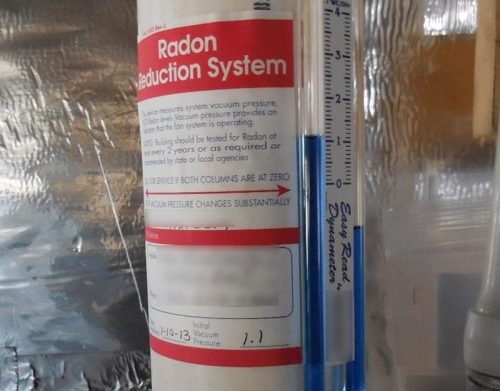If you want to have a radon mitigation system installed in your home, you might need a permit. As I’ve shown in past blog posts about hot roofs and Diamond Piers, requirements and interpretations of the building code can vary from city to city. While attending a recent meeting of the Minnesota Association of Radon Professionals, I was surprised to hear one of the board members say that about half of the cities in Minnesota already require permits for radon mitigation systems.
Side note: I’ve always called them radon mitigation systems. Some call them Radon Reduction Systems, others call them Radon Control Systems. We’re all talking about the same thing.
 The current rules
The current rules
When Minnesota adopted a new building code in 2015, the requirements for radon systems changed a bit. I blogged about those changes here: http://structuretech1.com/new-radon-rules-for-mn/. Section 1303.2400 says that sections 1303.2400 to 1303.2402 address passive mitigation systems in new construction. My interpretation is that those sections do not apply to existing homes. The only portion that might apply to existing homes is section 1303.2403, Requirements for Active Radon Control Systems. That code section doesn’t say whether it applies to existing homes or not.
To help address this, the Minnesota Department of Labor and Industry has published a fact sheet titled “Radon Control Systems“. At the top of page 2, you can find the following Q&A:
Are permits and inspections required for the installation of radon control systems?
Yes. Building permits and inspections are required for passive and active control systems.
Do the requirements for radon control systems apply to radon remediation work in existing homes?
No. Passive radon control systems are only required in new residential structures (section 1303.2400 subp. 1). Requirements for active radon control systems would only apply when adding a fan to an existing home that already has a (code compliant) passive radon control system in place (section 1303.2403).
So what does all that mean? I don’t know. My interpretation is that the building code only addresses radon in new construction or additions, not existing construction. To see how different cities throughout Minnesota are addressing this, I contacted the building inspections departments for most of the largest cities here in Minnesota. I asked them if a permit is required to install a radon mitigation system in an existing home.
As you can see from my results below, there is a lot of disagreement about this topic. Some cities require a permit, some don’t. One large city actually had two different people get back to me, one saying permits are required and the other saying they’re not. No joke. I omitted that city from my list.
| Apple Valley | No |
| Blaine | Yes |
| Bloomington | No |
| Brooklyn Park | Yes |
| Burnsville | No |
| Coon Rapids | Yes |
| Eagan | Yes |
| Eden Prairie | Yes |
| Edina | No |
| Lakeville | No |
| Mankato | Yes |
| Maple Grove | No |
| Minneapolis | Yes |
| Minnetonka | No |
| Moorhead | No |
| Plymouth | No |
| Richfield | No |
| Rochester | No |
| Saint Paul | Yes |
| Shakopee | Yes |
| St. Cloud | No |
| St. Louis Park | No |
| Woodbury | No |
For the cities that require a permit, expect the total cost of a mitigation system to be about $200 – $300 more than cities without permit requirements. This is because radon mitigation contractors are passing along the permit fee to the client, as well as an upcharge for their added time to obtain the permit.

Matt
July 11, 2017, 7:41 am
https://www.blainemn.gov/DocumentCenter/View/1569 page 2 indicates that installing a Radon Mitigation system does require a permit for Blaine, MN
Reuben Saltzman
July 11, 2017, 12:13 pm
Very helpful, thank you!